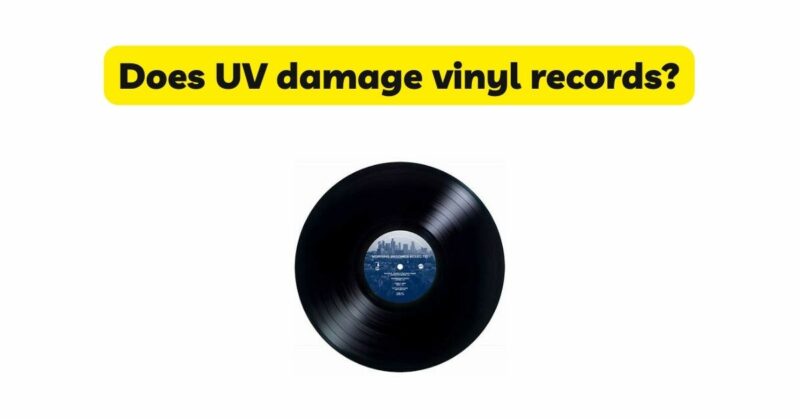Vinyl records have made a remarkable resurgence in recent years, capturing the hearts of music enthusiasts with their rich sound and tactile appeal. As vinyl collectors, we strive to protect and preserve our cherished collections from various forms of damage. Among the concerns that arise is the potential harm caused by ultraviolet (UV) radiation. In this article, we will explore the effects of UV radiation on vinyl records, examine the science behind its impact, and provide practical tips to safeguard your valuable vinyl collection.
Understanding UV Radiation and Its Effects:
Ultraviolet radiation, present in sunlight and some artificial light sources, consists of invisible rays that can have both beneficial and damaging effects. When it comes to vinyl records, UV radiation primarily poses risks due to its ability to degrade materials and alter their properties.
- Discoloration and Fading: UV radiation can cause the discoloration and fading of vinyl records. Over time, exposure to UV rays can break down the chemical bonds in the record’s protective coating, resulting in a loss of vibrancy and fading of the record’s artwork and labels. This not only affects the visual appeal but can also diminish the overall value of the record.
- Deterioration of PVC Material: The primary material used in vinyl records is polyvinyl chloride (PVC), which can be susceptible to degradation when exposed to UV radiation. UV rays can break down the chemical structure of PVC, leading to a loss of flexibility, brittleness, and potential damage to the grooves that store the audio information. This degradation can result in diminished sound quality and ultimately render the record unplayable.
Dispelling Myths:
- “UV damage only occurs from direct sunlight”: While direct sunlight is a significant source of UV radiation, it is not the only factor to consider. Indirect sunlight, as well as artificial light sources that emit UV rays, can also contribute to UV damage over time. It is important to be aware of the cumulative effects of UV exposure, even in indoor environments.
- “UV damage is instantaneous”: UV damage to vinyl records occurs gradually over time. It is a cumulative process, with the severity of the damage dependent on factors such as the intensity and duration of UV exposure. The effects may not be immediately noticeable, but continuous exposure can lead to significant deterioration over the long term.
Protecting Your Vinyl Collection:
- Storage Location: Choose an optimal storage location for your vinyl records, away from direct sunlight and artificial light sources that emit UV radiation. Consider a cool, dry, and shaded area within your home, such as an interior room or a dedicated vinyl storage unit. Avoid storing records near windows or glass surfaces that can amplify UV radiation.
- UV-Blocking Sleeves: Utilize UV-blocking inner sleeves to provide an additional layer of protection against UV radiation. These sleeves are specifically designed to filter out harmful UV rays while allowing visible light to pass through. Using UV-blocking sleeves can significantly reduce the risk of discoloration and fading, preserving the visual appeal of your vinyl records.
- Display Cases and Covers: If you choose to display your vinyl records, consider using display cases or shelves that offer UV protection. These specialized cases use materials that filter out UV radiation, minimizing the potential damage caused by light exposure. Additionally, using outer protective covers for individual records provides an extra layer of defense against UV radiation and dust.
- Limited Sunlight Exposure: If you prefer to keep your records in a room with natural light, position your storage shelves or units away from direct sunlight. Consider using blinds, curtains, or UV-filtering films on windows to reduce the amount of UV radiation that reaches your records.
- Regular Rotation: Regularly rotate your vinyl recordsto minimize the effects of UV exposure. By periodically swapping records between storage spaces, you ensure that no single record is consistently exposed to UV radiation for prolonged periods. This practice helps distribute any potential damage more evenly across your collection.
- Monitoring and Controlling Environmental Factors: In addition to UV radiation, other environmental factors can impact the condition of your vinyl records. Maintain a stable temperature and humidity level in the storage area to prevent warping, mold growth, and other forms of damage. Avoid areas with excessive heat, high humidity, or extreme temperature fluctuations, as these conditions can exacerbate the effects of UV radiation.
Conclusion:
While UV radiation can indeed damage vinyl records, it is important to approach the topic with a balanced perspective. UV damage occurs gradually over time, leading to discoloration, fading, and degradation of the record’s protective coating and PVC material. However, by implementing practical measures to protect your vinyl collection, you can significantly reduce the risk of UV damage.Choosing an optimal storage location, utilizing UV-blocking sleeves and protective covers, limited exposure to sunlight, regular rotation, and monitoring environmental factors are key steps in preserving the quality and longevity of your vinyl records. By taking these precautions, you can enjoy your vinyl collection with peace of mind, knowing that you have minimized the potential harm caused by UV radiation.Remember, the joy of vinyl records lies in their ability to provide an immersive listening experience. By safeguarding your collection from UV damage and other forms of deterioration, you ensure that your vinyl records continue to bring you countless hours of enjoyment while maintaining their value as treasured musical artifacts.

